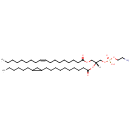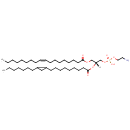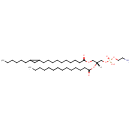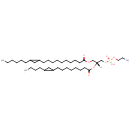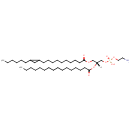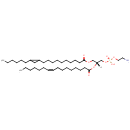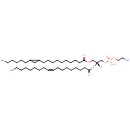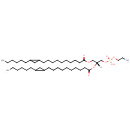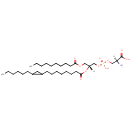
Search Results for compounds
Searching compounds for
returned 4373 results.
Displaying compounds 2681 - 2690 of
4373 in total
PE(18:1(9Z)/19:0cycv8c) (PAMDB006690)
IUPAC:
(2-aminoethoxy)[(2R)-2-{[10-(2-hexylcyclopropyl)decanoyl]oxy}-3-[(9Z)-octadec-9-enoyloxy]propoxy]phosphinic acid
CAS: Not Available
Description: PE(18:1(9Z)/19:0cycv8c) is a phosphatidylethanolamine. It is a glycerophospholipid in which a phosphorylethanolamine moiety occupies a glycerol substitution site. As is the case with diacylglycerols, glycerophosphoethanolamines can have many different combinations of fatty acids of varying lengths and saturation attached to the C-1 and C-2 atoms. PE(18:1(9Z)/19:0cycv8c), in particular, consists of one 9Z-octadecenoyl chain to the C-1 atom, and one heptadec-11-12-cyclo-anoyl to the C-2 atom. While most phospholipids have a saturated fatty acid on C-1 and an unsaturated fatty acid on C-2 of the glycerol backbone, the fatty acid distribution at the C-1 and C-2 positions of glycerol within phospholipids is continually in flux, owing to phospholipid degradation and the continuous phospholipid remodeling that occurs while these molecules are in membranes. PEs are neutral zwitterions at physiological pH. They mostly have palmitic or stearic acid on carbon 1 and a long chain unsaturated fatty acid (e.g. 18:2, 20:4 and 22:6) on carbon 2. PE synthesis can occur via two pathways. The first requires that ethanolamine be activated by phosphorylation and then coupled to CDP. The ethanolamine is then transferred from CDP-ethanolamine to phosphatidic acid to yield PE. The second involves the decarboxylation of PS.
PE(18:1(9Z)/19:0cycw8c) (PAMDB006691)
IUPAC:
(2-aminoethoxy)[(2R)-2-{[9-(2-heptylcyclopropyl)nonanoyl]oxy}-3-[(9Z)-octadec-9-enoyloxy]propoxy]phosphinic acid
CAS: Not Available
Description: PE(18:1(9Z)/19:0cycw8c) is a phosphatidylethanolamine. It is a glycerophospholipid in which a phosphorylethanolamine moiety occupies a glycerol substitution site. As is the case with diacylglycerols, glycerophosphoethanolamines can have many different combinations of fatty acids of varying lengths and saturation attached to the C-1 and C-2 atoms. PE(18:1(9Z)/19:0cycw8c), in particular, consists of one 9Z-octadecenoyl chain to the C-1 atom, and one 9-(2-heptylcyclopropyl)nonanoyl to the C-2 atom. While most phospholipids have a saturated fatty acid on C-1 and an unsaturated fatty acid on C-2 of the glycerol backbone, the fatty acid distribution at the C-1 and C-2 positions of glycerol within phospholipids is continually in flux, owing to phospholipid degradation and the continuous phospholipid remodeling that occurs while these molecules are in membranes. PEs are neutral zwitterions at physiological pH. They mostly have palmitic or stearic acid on carbon 1 and a long chain unsaturated fatty acid (e.g. 18:2, 20:4 and 22:6) on carbon 2. PE synthesis can occur via two pathways. The first requires that ethanolamine be activated by phosphorylation and then coupled to CDP. The ethanolamine is then transferred from CDP-ethanolamine to phosphatidic acid to yield PE. The second involves the decarboxylation of PS.
PE(19:0cycv8c/14:0) (PAMDB006693)
IUPAC:
(2-aminoethoxy)[(2R)-3-{[10-(2-hexylcyclopropyl)decanoyl]oxy}-2-(tetradecanoyloxy)propoxy]phosphinic acid
CAS: Not Available
Description: PE(19:0cycv8c/14:0) is a phosphatidylethanolamine. It is a glycerophospholipid in which a phosphorylethanolamine moiety occupies a glycerol substitution site. As is the case with diacylglycerols, glycerophosphoethanolamines can have many different combinations of fatty acids of varying lengths and saturation attached to the C-1 and C-2 atoms. PE(19:0cycv8c/14:0), in particular, consists of one heptadec-11-12-cyclo-anoyl chain to the C-1 atom, and one tetradecanoyl to the C-2 atom. While most phospholipids have a saturated fatty acid on C-1 and an unsaturated fatty acid on C-2 of the glycerol backbone, the fatty acid distribution at the C-1 and C-2 positions of glycerol within phospholipids is continually in flux, owing to phospholipid degradation and the continuous phospholipid remodeling that occurs while these molecules are in membranes. PEs are neutral zwitterions at physiological pH. They mostly have palmitic or stearic acid on carbon 1 and a long chain unsaturated fatty acid (e.g. 18:2, 20:4 and 22:6) on carbon 2. PE synthesis can occur via two pathways. The first requires that ethanolamine be activated by phosphorylation and then coupled to CDP. The ethanolamine is then transferred from CDP-ethanolamine to phosphatidic acid to yield PE. The second involves the decarboxylation of PS.
PE(19:0cycv8c/15:0cyclo) (PAMDB006694)
IUPAC:
(2-aminoethoxy)[(2R)-2-{[8-(2-butylcyclopropyl)octanoyl]oxy}-3-{[10-(2-hexylcyclopropyl)decanoyl]oxy}propoxy]phosphinic acid
CAS: Not Available
Description: PE(19:0cycv8c/15:0cyclo) is a phosphatidylethanolamine. It is a glycerophospholipid in which a phosphorylethanolamine moiety occupies a glycerol substitution site. As is the case with diacylglycerols, glycerophosphoethanolamines can have many different combinations of fatty acids of varying lengths and saturation attached to the C-1 and C-2 atoms. PE(19:0cycv8c/15:0cyclo), in particular, consists of one heptadec-11-12-cyclo-anoyl chain to the C-1 atom, and one cis-9,10-Methylenetetradecanoic acid to the C-2 atom. While most phospholipids have a saturated fatty acid on C-1 and an unsaturated fatty acid on C-2 of the glycerol backbone, the fatty acid distribution at the C-1 and C-2 positions of glycerol within phospholipids is continually in flux, owing to phospholipid degradation and the continuous phospholipid remodeling that occurs while these molecules are in membranes. PEs are neutral zwitterions at physiological pH. They mostly have palmitic or stearic acid on carbon 1 and a long chain unsaturated fatty acid (e.g. 18:2, 20:4 and 22:6) on carbon 2. PE synthesis can occur via two pathways. The first requires that ethanolamine be activated by phosphorylation and then coupled to CDP. The ethanolamine is then transferred from CDP-ethanolamine to phosphatidic acid to yield PE. The second involves the decarboxylation of PS.
PE(19:0cycv8c/16:0) (PAMDB006695)
IUPAC:
(2-aminoethoxy)[(2R)-2-(hexadecanoyloxy)-3-{[10-(2-hexylcyclopropyl)decanoyl]oxy}propoxy]phosphinic acid
CAS: Not Available
Description: PE(19:0cycv8c/16:0) is a phosphatidylethanolamine. It is a glycerophospholipid in which a phosphorylethanolamine moiety occupies a glycerol substitution site. As is the case with diacylglycerols, glycerophosphoethanolamines can have many different combinations of fatty acids of varying lengths and saturation attached to the C-1 and C-2 atoms. PE(19:0cycv8c/16:0), in particular, consists of one heptadec-11-12-cyclo-anoyl chain to the C-1 atom, and one hexadecanoyl to the C-2 atom. While most phospholipids have a saturated fatty acid on C-1 and an unsaturated fatty acid on C-2 of the glycerol backbone, the fatty acid distribution at the C-1 and C-2 positions of glycerol within phospholipids is continually in flux, owing to phospholipid degradation and the continuous phospholipid remodeling that occurs while these molecules are in membranes. PEs are neutral zwitterions at physiological pH. They mostly have palmitic or stearic acid on carbon 1 and a long chain unsaturated fatty acid (e.g. 18:2, 20:4 and 22:6) on carbon 2. PE synthesis can occur via two pathways. The first requires that ethanolamine be activated by phosphorylation and then coupled to CDP. The ethanolamine is then transferred from CDP-ethanolamine to phosphatidic acid to yield PE. The second involves the decarboxylation of PS.
PE(19:0cycv8c/16:1(9Z)) (PAMDB006696)
IUPAC:
(2-aminoethoxy)[(2R)-2-[(9Z)-hexadec-9-enoyloxy]-3-{[10-(2-hexylcyclopropyl)decanoyl]oxy}propoxy]phosphinic acid
CAS: Not Available
Description: PE(19:0cycv8c/16:1(9Z)) is a phosphatidylethanolamine. It is a glycerophospholipid in which a phosphorylethanolamine moiety occupies a glycerol substitution site. As is the case with diacylglycerols, glycerophosphoethanolamines can have many different combinations of fatty acids of varying lengths and saturation attached to the C-1 and C-2 atoms. PE(19:0cycv8c/16:1(9Z)), in particular, consists of one heptadec-11-12-cyclo-anoyl chain to the C-1 atom, and one 9Z-hexadecenoyl to the C-2 atom. While most phospholipids have a saturated fatty acid on C-1 and an unsaturated fatty acid on C-2 of the glycerol backbone, the fatty acid distribution at the C-1 and C-2 positions of glycerol within phospholipids is continually in flux, owing to phospholipid degradation and the continuous phospholipid remodeling that occurs while these molecules are in membranes. PEs are neutral zwitterions at physiological pH. They mostly have palmitic or stearic acid on carbon 1 and a long chain unsaturated fatty acid (e.g. 18:2, 20:4 and 22:6) on carbon 2. PE synthesis can occur via two pathways. The first requires that ethanolamine be activated by phosphorylation and then coupled to CDP. The ethanolamine is then transferred from CDP-ethanolamine to phosphatidic acid to yield PE. The second involves the decarboxylation of PS.
PE(19:0cycv8c/17:0cycw7c) (PAMDB006697)
IUPAC:
(2-aminoethoxy)[(2R)-3-{[10-(2-hexylcyclopropyl)decanoyl]oxy}-2-{[8-(2-hexylcyclopropyl)octanoyl]oxy}propoxy]phosphinic acid
CAS: Not Available
Description: PE(19:0cycv8c/17:0cycw7c) is a phosphatidylethanolamine. It is a glycerophospholipid in which a phosphorylethanolamine moiety occupies a glycerol substitution site. As is the case with diacylglycerols, glycerophosphoethanolamines can have many different combinations of fatty acids of varying lengths and saturation attached to the C-1 and C-2 atoms. PE(19:0cycv8c/17:0cycw7c), in particular, consists of one heptadec-11-12-cyclo-anoyl chain to the C-1 atom, and one heptadec-9-10-cyclo-anoyl to the C-2 atom. While most phospholipids have a saturated fatty acid on C-1 and an unsaturated fatty acid on C-2 of the glycerol backbone, the fatty acid distribution at the C-1 and C-2 positions of glycerol within phospholipids is continually in flux, owing to phospholipid degradation and the continuous phospholipid remodeling that occurs while these molecules are in membranes. PEs are neutral zwitterions at physiological pH. They mostly have palmitic or stearic acid on carbon 1 and a long chain unsaturated fatty acid (e.g. 18:2, 20:4 and 22:6) on carbon 2. PE synthesis can occur via two pathways. The first requires that ethanolamine be activated by phosphorylation and then coupled to CDP. The ethanolamine is then transferred from CDP-ethanolamine to phosphatidic acid to yield PE. The second involves the decarboxylation of PS.
PE(19:0cycv8c/18:1(9Z)) (PAMDB006698)
IUPAC:
(2-aminoethoxy)[(2R)-3-{[10-(2-hexylcyclopropyl)decanoyl]oxy}-2-[(9Z)-octadec-9-enoyloxy]propoxy]phosphinic acid
CAS: Not Available
Description: PE(19:0cycv8c/18:1(9Z)) is a phosphatidylethanolamine. It is a glycerophospholipid in which a phosphorylethanolamine moiety occupies a glycerol substitution site. As is the case with diacylglycerols, glycerophosphoethanolamines can have many different combinations of fatty acids of varying lengths and saturation attached to the C-1 and C-2 atoms. PE(19:0cycv8c/18:1(9Z)), in particular, consists of one heptadec-11-12-cyclo-anoyl chain to the C-1 atom, and one 9Z-octadecenoyl to the C-2 atom. While most phospholipids have a saturated fatty acid on C-1 and an unsaturated fatty acid on C-2 of the glycerol backbone, the fatty acid distribution at the C-1 and C-2 positions of glycerol within phospholipids is continually in flux, owing to phospholipid degradation and the continuous phospholipid remodeling that occurs while these molecules are in membranes. PEs are neutral zwitterions at physiological pH. They mostly have palmitic or stearic acid on carbon 1 and a long chain unsaturated fatty acid (e.g. 18:2, 20:4 and 22:6) on carbon 2. PE synthesis can occur via two pathways. The first requires that ethanolamine be activated by phosphorylation and then coupled to CDP. The ethanolamine is then transferred from CDP-ethanolamine to phosphatidic acid to yield PE. The second involves the decarboxylation of PS.
PE(19:0cycv8c/19:0cycv8c) (PAMDB006699)
IUPAC:
(2-aminoethoxy)[(2R)-2,3-bis({[10-(2-hexylcyclopropyl)decanoyl]oxy})propoxy]phosphinic acid
CAS: Not Available
Description: PE(19:0cycv8c/19:0cycv8c) is a phosphatidylethanolamine. It is a glycerophospholipid in which a phosphorylethanolamine moiety occupies a glycerol substitution site. As is the case with diacylglycerols, glycerophosphoethanolamines can have many different combinations of fatty acids of varying lengths and saturation attached to the C-1 and C-2 positions. PE(19:0cycv8c/19:0cycv8c), in particular, consists of two heptadec-11-12-cyclo-anoyl chains at positions C-1 and C-2. While most phospholipids have a saturated fatty acid on C-1 and an unsaturated fatty acid on C-2 of the glycerol backbone, the fatty acid distribution at the C-1 and C-2 positions of glycerol within phospholipids is continually in flux, owing to phospholipid degradation and the continuous phospholipid remodeling that occurs while these molecules are in membranes. PEs are neutral zwitterions at physiological pH. They mostly have palmitic or stearic acid on carbon 1 and a long chain unsaturated fatty acid (e.g. 18:2, 20:4 and 22:6) on carbon 2. PE synthesis can occur via two pathways. The first requires that ethanolamine be activated by phosphorylation and then coupled to CDP. The ethanolamine is then transferred from CDP-ethanolamine to phosphatidic acid to yield PE. The second involves the decarboxylation of PS.
PS(10:0/17:0cycw7c) (PAMDB006708)
IUPAC:
(2S)-2-amino-3-({[(2R)-3-(decanoyloxy)-2-{[8-(2-hexylcyclopropyl)octanoyl]oxy}propoxy](hydroxy)phosphoryl}oxy)propanoic acid
CAS: Not Available
Description: PS(10:0/17:0cycw7c) is a phosphatidylserine. It is a glycerophospholipid in which a phosphorylserine moiety occupies a glycerol substitution site. As is the case with diacylglycerols, phosphatidylserines can have many different combinations of fatty acids of varying lengths and saturation attached to the C-1 and C-2 atoms.. PS(10:0/17:0cycw7c), in particular, consists of one decanoyl chain to the C-1 atom, and one heptadec-9-10-cyclo-anoyl to the C-2 atom. Phosphatidylserine or 1,2-diacyl-sn-glycero-3-phospho-L-serine is distributed widely among animals, plants and microorganisms. Phosphatidylserine is an acidic (anionic) phospholipid with three ionizable groups, i.e. the phosphate moiety, the amino group and the carboxyl function. As with other acidic lipids, it exists in nature in salt form, but it has a high propensity to chelate to calcium via the charged oxygen atoms of both the carboxyl and phosphate moieties, modifying the conformation of the polar head group. This interaction may be of considerable relevance to the biological function of phosphatidylserine. While most phospholipids have a saturated fatty acid on C-1 and an unsaturated fatty acid on C-2 of the glycerol backbone, the fatty acid distribution at the C-1 and C-2 positions of glycerol within phospholipids is continually in flux, owing to phospholipid degradation and the continuous phospholipid remodeling that occurs while these molecules are in membranes. Phosphatidylserines typically carry a net charge of -1 at physiological pH. They mostly have palmitic or stearic acid on carbon 1 and a long chain unsaturated fatty acid (e.g. 18:2, 20:4 and 22:6) on carbon 2. PS biosynthesis involves an exchange reaction of serine for ethanolamine in PE.
